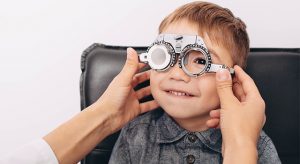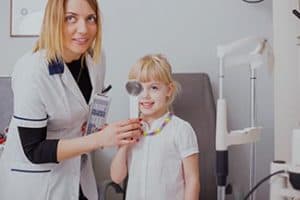Not sure if your child needs glasses?
Here are 7 signs to look out for.
Vision problems can impact a child’s development and affect their ability to succeed both inside and outside the classroom.
Eye doctors prescribe glasses to children to correct blurry vision and ensure clear and comfortable vision — allowing them to fulfill their potential in the classroom.
The American Optometric Association (AOA) recommends bringing children for an annual eye exam from as young as six months of age to ensure their eyes and vision are developing properly.
Regular eye exams facilitate early identification and treatment of any visual problems that may be hindering a child’s development.
However, since children don’t often complain of vision difficulties— usually because they simply don’t realize that they are seeing differently than everyone else— it is important for parents to be able to recognize the signs of a vision problem.
Early detection of a vision problem, along with early treatment, can save a child years of struggle and facilitate academic, athletic and social success.
Here are 7 signs that your child may need glasses.
1. Squinting
Squinting helps to temporarily improve the clarity of an image. It is also a common symptom of nearsightedness (myopia) and farsightedness (hyperopia).
2. Headaches
Headaches, especially at the end of the school day or with prolonged digital device usage, can be a sign that your child is overexerting their eye muscles in an effort to increase focus and vision clarity.
Headaches can be a symptom of a range of different vision problems.
SEE RELATED: Eye Exams for Children
If your child is showing any signs of a vision problem, schedule an eye exam to see if they can benefit from glasses.
3. Sitting too close to the TV or computer screen
Sitting too close to the TV or holding a digital device too close to the eyes may be signs of poor distance vision caused by myopia.
4. Eye rubbing
Excessive eye rubbing may be a sign of eye strain or fatigue caused by poor visual clarity. These symptoms can accompany several different vision problems.
5. Frequent head tilting
Head tilting helps to eliminate double vision by changing the way an image is viewed. Often, head tilting is a sign of an eye misalignment.
6. Covering one eye
Covering one eye when participating in near-vision activities, such as reading or playing on a handheld device, is often a sign of reduced visual clarity. It can also indicate an eye misalignment or a lazy eye.
7. Difficulty reading
Reading difficulties are often misdiagnosed as a learning difficulty, when a vision problem is really at its root.
If your child often loses their place while reading, skips words or lines, complains that words are ‘jumping’ on the page, or makes it a point to use their finger to help them follow the text, they may have a vision problem.
Are glasses always the answer?
No, not always.
Vision problems caused by a refractive error, such as myopia, hyperopia or astigmatism are generally corrected with glasses or contact lenses.
But some vision problems, like lazy eye and convergence insufficiency, require other methods of treatment, such as vision therapy to retrain the eyes and brain for more effective communication.
In some cases, glasses with or without prism lenses will be prescribed along with a vision therapy program.
If your child does need glasses to improve their vision clarity, there are many different styles, shapes and sizes available for them to choose from – so your child will not only begin to see better, but will feel confident with their new look.
LEARN MORE: Guide to Children’s Eye Exams
If you suspect that your child has a vision problem, schedule an appointment with an eye doctor near you.
Since children don’t often complain of vision difficulties, it is important for parents to be able to recognize the signs of a vision problem.
Early detection of a vision problem, along with early treatment, can save a child years of struggle and allow them to blossom both inside and outside the classroom.










